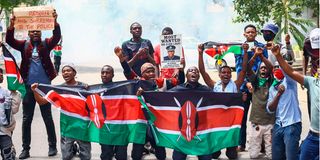
Demonstrators protest on Harambee Avenue on June 12, 2025 demanding justice for Albert Ojwang who died in police custody at Nairobi's Central Police Station.
As discontent with President William Ruto’s government continues to fester, Kenya is increasingly trapped in a dangerous revolutionary moment. On June 25, 2025, thousands of Kenya’s young people poured into the streets to commemorate the 60 people killed during the June 2024 Gen Z-led anti-tax uprising and to protest against widespread police brutality.
Sixteen people were killed, over 400 others injured and property worth billions destroyed in riots that engulfed 27 of Kenya’s 47 counties. Spectacularly, Kenya is caught up in a titanic clash between the idea of freedom unbound that inspired its 2010 Constitution and a new brutal wave of recidivistic tyranny, a throwback to the one-party era.
In this configuration, the vision of Kenya as a progressive people-centered democracy faces the headwinds of a resurgent authoritarian ‘criminal state’ model. Framing this clash is the idea of a ‘clash of generations.’
Kenya’s young people — with over 80 per cent of the population being below 35 years — are facing the full wrath of a small but powerful ruling ‘gerontocracy.’ The Government’s response to youth-led protests has given birth to the Frankenstein monster of a criminal state whose rise is ominously turning Kenya’s youth boom from a blessing to a deadly curse. Kenyan patriots, intellectuals, regional and international partners can’t afford to dither or fiddle as the country burns.
Youth protests
Certainly, Kenya is burning. The youth protests reflect a serious failure of leadership to transform the gains of Kenya’s youth boom under President Mwai Kibaki into a development dividend envisioned in Kenya Vision 2030.
Kibaki government’s Free Primary Education (FPE) and subsidised secondary education boosted enrolment rates in education while improvements in healthcare and living standards amid continued high fertility rates and a decline in infant mortality rates fuelled Kenya’s youth bulge or boom as a potential blessing with huge development dividends.
Sadly, the deadly youth-led protests in 2023, 2024 and 2025 reveal the failure of Kibaki’s successors to turn the youth bulge into an economic dividend as a national priority. Not surprisingly, 2013-2025 looms large as the lost decade for Kenya’s youth. Neither Uhuru Kenyatta’s hyped “Big Four” Agenda nor William Ruto’s populist “Bottom-Up Economic Model,” as intermediate plans to realise the Kenya Vision 2030, managed to centre the youth as the fulcrum of the economy or make serious gains in turning the country’s youth boom into a development dividend.
With many policy reforms targeting the youth cohort over the last 13 years being showy, top-heavy, basically populist and grossly underfunded ‘PR projects,’ Kenya’s youth have one of the highest unemployment rates of 67 per cent.
By not empowering the youth to drive the economy and adequately equipping them with the right skill sets to be gainfully engaged in the marketplace, Kenya’s post-Kibaki rulers planted the wind, and the country is now reaping the whirlwind of youth discontent over poverty and unemployment.
Youth discontent
The Government’s heavy-handed approach to managing youth discontent has birthed a dangerous Frankenstein monster of a criminal state focused on self-survival rather than national transformation. Normally, modern states are based on the principle of the ‘Responsibility to Protect” citizens.
Therefore, in a perfect situation, a government has a duty to protect its people, provide for their security and well-being and help them prosper. But when the same government that enforces the law begins to commit crimes against its citizens, a criminal state is born.
A state becomes criminal when the government begins to rule outside the established law of the land. The governing elite uses state institutions as instruments to commit crimes against humanity or to prevent the investigation and prosecution of crimes such as abducting and killing citizens to gain or stay in power. Dictators have adopted cruel policies such as poisoning water wells, razing down food stores or grain fields, resulting in mass poverty, starvation and death.
In the wake of the Gen-Z protests in 2024, Kenya shrilly evolved into a perfect criminal State. The resurgence of criminal State prototype in Kenya as elsewhere has provoked debate about the future of freedom. In their widely read article, “Defining Criminal-States” (2006), Robert J. Bunker and Pamela L. Bunker, characterise the criminal-state as “a new form of dangerous state.” But criminal states are as old as the hills.
Criminal state
Actually, history is littered with skeletons of failed criminal states. In Europe, a totalitarian state under Adolf Hitler in Nazi Germany (1933 to 1945) killed more than six million of its Jewish citizens. In Africa, Idi Amin (1971-1979) slaughtered hundreds of thousands of his Ugandan countrymen in one of Africa’s deadliest criminal states.
Kenya’s emerging criminal state model carries the three ugly birthmarks of a prototype criminal state. One, it is a repressive state that uses the force of the military, the police, the judiciary, and the prison system against its citizens. Two, it is a corrupt state where elected government officials use bribery, lobbying, extortion, cronyism, nepotism and influence peddling for personal gain.
According to the Transparency International, in the 2024 Kenya was one of the most corrupt states globally, ranking 121 out of 180 countries in its Corruption Perceptions Index. Three, it is negligent state that is unable or unwilling to alleviate the suffering posed to its people by disease, poverty and unemployment. Instead, it has breached the duty of care by not holding criminals to account, covering them up or letting them go scot-free.
The greatest paradox of our time is how the criminal state model is thriving in democracies, existing side by side with democratic constitutions like that of Kenya. In the aftermath of the June protests, Interior Cabinet Secretary Kipchumba Murkomen has stoked controversy and public ire by issuing a shoot-to-kill order.
Obviously, a criminal state is not a solution to Kenya’s youth development crisis. A more sustainable solution is to invest in entrepreneurial and leadership capacities of the youth, enhancing their employable skills, creativity and innovation as the white knight nights and future of a modern technology-driven economy.
Professor Peter Kagwanja is former Government Adviser and Chief Executive of Africa Policy Institute (API).










